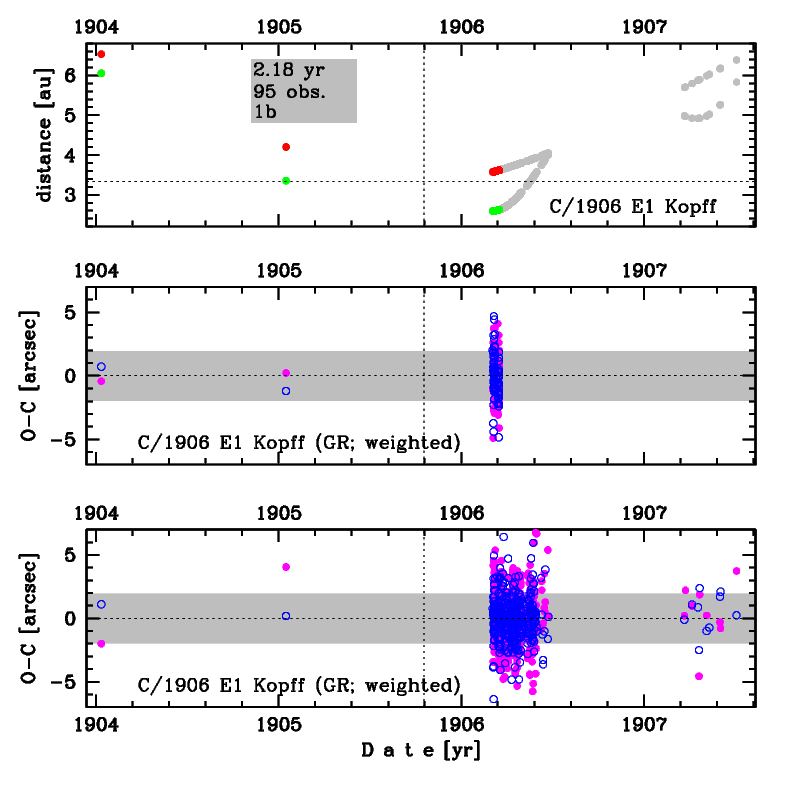C/1906 E1 Kopff
more info
Comet C/1906 E1 was discovered on 4 March 1906, 4.5 months after perihelion passage, and was last seen on 4 July 1907 [Kronk, Cometography: Volume 3].Soon, the comet was found on two photographic plates exposed on 15 January 1905 and 10 January 1904 in Königstuhl Observatory (Heidelberg).
This comet made its closest approach to the Earth on 2 March 1906 (2.60 au), that is two days before its discovery.
E.E. Barnard (Yerkes Observatory) observed secondary faint component (3-4 magnitudes fainter than the principal nucleus) between the period of 1906 March 17 – 1906 March 31 (AJ 1908, Vol. 25, 83). At that time, the comet was at a distance of about 3.6 au from the Sun and 2.6 au from the Earth and just five months after perihelion passage.
Two solutions given here are based on data spanning over 3.48 yr in a range of heliocentric distances from 6.53 au through perihelion (3.34 au) to 6.38 au; however the preferred orbit is based on shorter arc of 2.18 yr including data only before the detection of secondary component.
This Oort spike comet suffers moderate planetary perturbations during its passage through the planetary system that lead to escape the comet from the solar system on a hyperbolic orbit (see future barycentric orbit).
C/1906 E1 is included to the list of split comets for unknown reasons in Comets II.
This comet made its closest approach to the Earth on 2 March 1906 (2.60 au), that is two days before its discovery.
E.E. Barnard (Yerkes Observatory) observed secondary faint component (3-4 magnitudes fainter than the principal nucleus) between the period of 1906 March 17 – 1906 March 31 (AJ 1908, Vol. 25, 83). At that time, the comet was at a distance of about 3.6 au from the Sun and 2.6 au from the Earth and just five months after perihelion passage.
Two solutions given here are based on data spanning over 3.48 yr in a range of heliocentric distances from 6.53 au through perihelion (3.34 au) to 6.38 au; however the preferred orbit is based on shorter arc of 2.18 yr including data only before the detection of secondary component.
This Oort spike comet suffers moderate planetary perturbations during its passage through the planetary system that lead to escape the comet from the solar system on a hyperbolic orbit (see future barycentric orbit).
C/1906 E1 is included to the list of split comets for unknown reasons in Comets II.
| solution description | ||
|---|---|---|
| number of observations | 97 | |
| data interval | 1904 01 10 – 1906 03 16 | |
| data arc selection | data generally limited to pre-perihelion (PRE) | |
| range of heliocentric distances | 6.53 au – 3.35 au (perihelion) – 3.62 au | |
| detectability of NG effects in the comet's motion | comet with determinable NG~orbit | |
| type of model of motion | GR - gravitational orbit | |
| data weighting | YES | |
| number of residuals | 166 | |
| RMS [arcseconds] | 1.80 | |
| orbit quality class | 1b | |
| orbital elements (heliocentric ecliptic J2000) | ||
|---|---|---|
| Epoch | 1905 10 02 | |
| perihelion date | 1905 10 18.51416710 | ± 0.03924524 |
| perihelion distance [au] | 3.33875628 | ± 0.00016725 |
| eccentricity | 0.99960249 | ± 0.00026474 |
| argument of perihelion [°] | 158.645341 | ± 0.007050 |
| ascending node [°] | 343.623636 | ± 0.000900 |
| inclination [°] | 4.282124 | ± 0.000316 |
| reciprocal semi-major axis [10-6 au-1] | 119.06 | ± 79.30 |

Upper panel: Time distribution of positional observations with corresponding heliocentric (red curve) and geocentric (green curve) distance at which they were taken. The horizontal dotted line shows the perihelion distance for a given comet whereas vertical dotted line — the moment of perihelion passage.
Lower panel (panels): O-C diagram for this(two) solution (solutions) given in this database, where residuals in right ascension are shown using magenta dots and in declination by blue open circles.
Lower panel (panels): O-C diagram for this(two) solution (solutions) given in this database, where residuals in right ascension are shown using magenta dots and in declination by blue open circles.